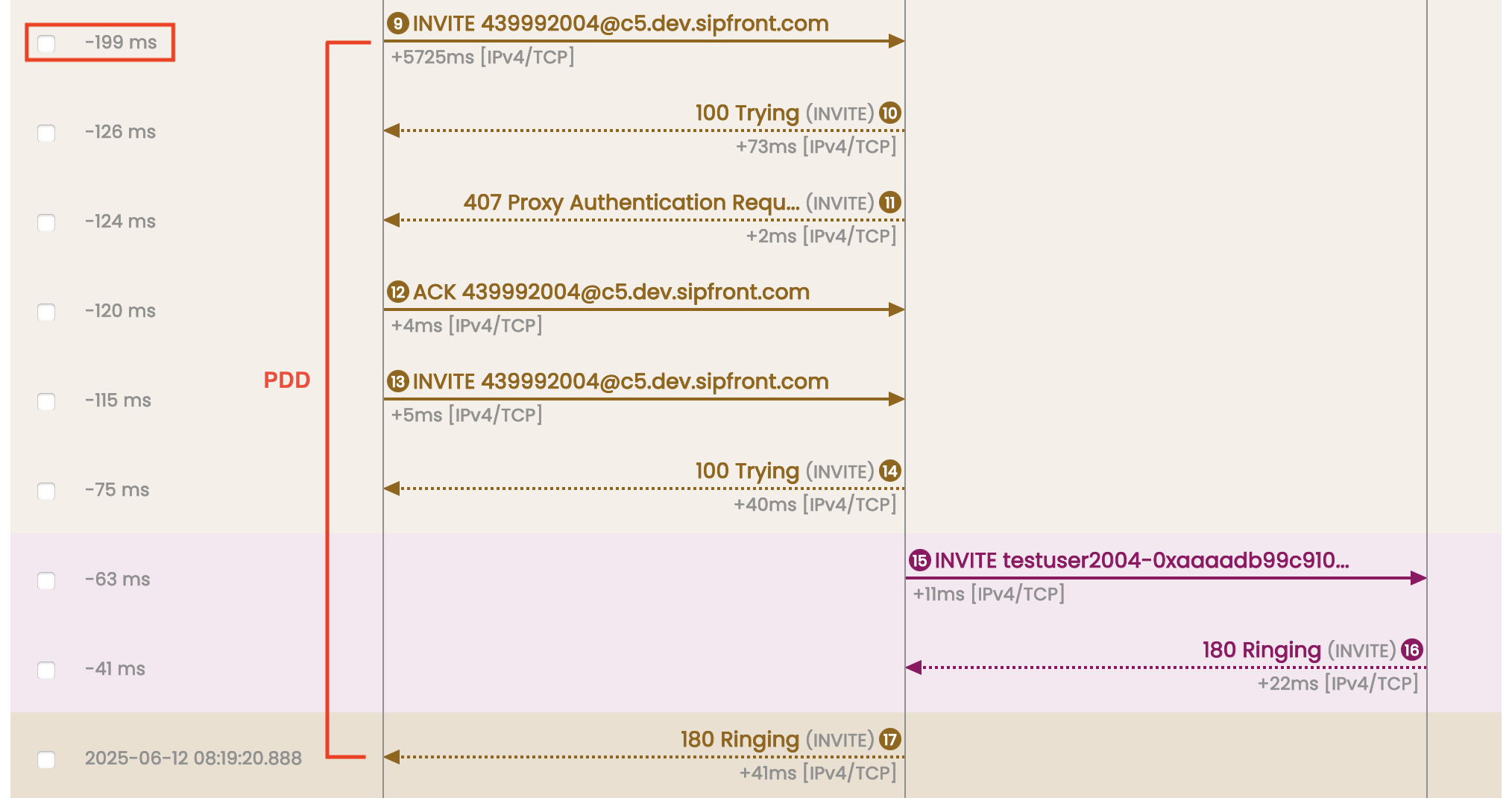Post Dial Delay (PDD) refers to the time interval between the moment a user completes dialing a number and when they hear the first indication that the call is being processed — typically a ringback tone or a progress announcement. In SIP-based systems, PDD is the period from the initial SIP INVITE sent by the PBX until the first SIP 18x (180 Ringing, 183 Session Progress) or 200 OK response is received.
This might include SIP messaging round-trips for authentication, as shown in the following sequence taken from a Sipfront Call Report:

In short, the definition of PDD is:
PDD = Time from first INVITE to first 18x/200 response.
Why PDD Matters for User Experience
PDD has a direct impact on how users perceive the responsiveness and quality of your telephony system:
- Short PDD: Users hear ringing quickly, which feels snappy and reliable.
- Long PDD: Users experience a “dead air” pause, often leading to confusion, repeated calls, or frustration.
Acceptable PDD
- Business VoIP: Generally <2 seconds is expected.
- Mobile networks: Up to 4 seconds may be tolerated, but lower is always better.
Common Causes of Excessive PDD
- Digit Collection Delays: Phone or PBX waits to see if the user will dial more digits (dial-plan timeouts or overlap dialing).
- SIP Trunk Setup Delays: Slow setup of new SIP/TLS connections, or high network latency.
- Slow Routing Logic: Delays due to external lookups (ENUM, LCR, DB queries).
- Codec/Media Negotiation: Excessive or slow negotiation adds time before ringback.
- Upstream Carrier Latency: Slow response from provider, sometimes out of your control.
How to Optimize PDD in PBX Systems
1. Disable Unnecessary Digit Collection
The overlap dialing mechanism is used very rarely in SIP environments, yet often Cisco Call-Manager setups do have long digit collection delays configured (up to 6s). On the PBX side, you can most certainly disable overlap dialing entirely, as an INVITE usually carries the full number already. Your mileage might vary here though, so check your specific PBX documentation and requirements.
On auto-provisioned phones, try to optimize the dial plans such that digit collection finishes as soon as certain number patterns are matched (e.g. 3- or 4-digit extension dialing, vs. outbound dialing of longer numbers with a breakout prefix)
2. Keep SIP/TLS Connections Warm
- For TCP/TLS, keep connections to your peers/carriers and phones persistent.
- Avoid reconnecting for each call - TLS handshake can add significant delay.
3. Optimize Codec and Media Handling
- Limit offered codecs to those actually needed.
- Pre-negotiate or fix codec selection where possible.
4. Monitor and Profile PDD
- Use opensource tools like sngrep, Wireshark, or other means to analyze SIP traces to pinpoint delay sources.
- Track PDD metrics per route and carrier for SLA enforcement.
- Use services such as Sipfront for continuous PDD monitoring and trend analysis.
5. Work with Carriers
- Choose upstream providers known for fast signaling and low latency.
- Test and monitor their performance regularly using services such as Sipfront.
Summary
Post Dial Delay is a critical metric for voice service quality. As a PBX administrator, you can optimize PDD by disabling unnecessary digit collection, keeping SIP/TLS connections alive, and streamlining routing and codec handling. Monitor your system, choose fast providers, and always keep an eye on the user experience.
comments powered by Disqus